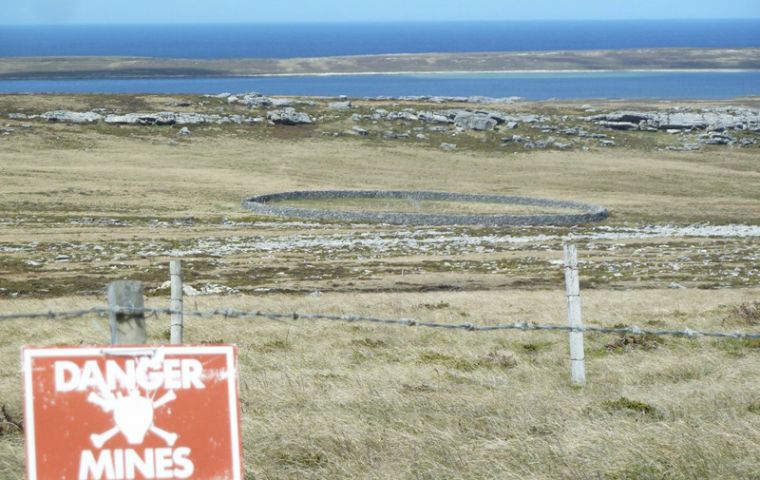MercoPress. South Atlantic News Agency
Falklands’ “land release” demining phase begins next week with 18 Zimbabweans
 Sappers Hill Corral, the large stone-walled corral, a Falklands’ landmark, remains behind minefield fences.
Sappers Hill Corral, the large stone-walled corral, a Falklands’ landmark, remains behind minefield fences. The team from BACTEC International Ltd that will be carrying out the second phase of the demining pilot project is in the Falklands are in the Islands and will look to release significant areas of land behind the Stanley Common fence to the South-west of the capital.
Following the 1982 South Atlantic conflict Argentina declared to the United Nations that it brought 25.000 landmines to the Falkland Islands at the start of the conflict (20.000 anti-personnel and 5.000 anti-vehicle mines) and that some 5.000 have been accounted for since the conflict ended.
This means that approximately 20,000 landmines remained in the ground prior to the 2009/2010 Phase 1 clearance and that this program cleared more than 6% of the remaining mine contamination.
The BACTEC team arrived in the Falklands on New Year’s Day and consists of eighteen Zimbabweans, fourteen of whom were involved in the original demining project in 2009/10, as well as five other team members.
BACTEC will be bringing in some specialist mechanical equipment for the project, including an armoured remote control tractor fitted with a flail, known as an Armtrak-75.
Project Manager Andy Frizzell said that the team this week is undergoing refresher training and preparing their equipment before the operations start on the 9th January. It is expected that the work will be completed by the 31st March.
Robin Swanson who is head of the Demining Program Office and visited the Falklands in early December ahead of the new phase anticipated that the process will now be moving from the pilot stage to a more advanced “land release” phase.
“The most important difference about this second phase is that the project aim is to release land which is currently unavailable for social use but is considered to be safe” said Swanson.
Perhaps most notable in this summer’s clearance will be the renewed access to Sappers Hill Corral. The large stone-walled corral is a notable Falklands’ landmark and was once a popular picnic spot for Stanley residents but has remained unvisited for 30 years behind minefield fences.
Swanson confirmed that during the clearance of Sapper Hill minefields and the demining of Surf Bay conducted in 2009/10 the number of mines encountered and destroyed matched with the number of documented mines laid from historical records.
Planning and preparing for the landmine clearances in the Falkland Islands by the UK Government has met with considerable challenges, not least what was determined “The Falkland’s Initiative”, a proposal by Islanders that to avoid the environmental damage that the de-mining process was believed to cause and the enormous financial cost of clearing mines that in practical terms represent scarcely any risk to civilians, the money should rather be spent on mine clearances in parts of the world where due to mines people are at a very real risk of death, injury or loss of livelihood.
However this has been overcome and MLA Mike Summers at the time explained the Falklands position regarding the situation pointing out that the UK Government has the legal responsibility for the removal of landmines placed by Argentine forces during the illegal invasion of the Falkland Islands in 1982, 20.000 anti-personnel mines and 5.000 anti-tank mines spread over 13 sq km in 117 locations in highly variable terrain.
“All the minefields in the Falkland Islands are fenced and clearly marked, and present no immediate danger to people. The people of the Falkland Islands are happy to see mine clearance carried out in other countries with more immediate dangers to their populations, but will support the UK in their task in the Islands”, said MLA Summers.
Swanson confirmed this saying that “we had a tremendous amount of support from the Islanders during the first phase of the pilot demining project and I am sure we will receive the same welcome and support again”.
Regarding Argentina MLA Summers said that Buenos Aires “has no jurisdiction in the Falkland Islands, and the people of the Falkland Islands have no wish to see Argentines here in any mine clearance role, albeit clearing up the mess they left behind. If Argentina wishes to make a financial contribution to clearance no doubt the UK Government would be happy to receive their offer”.
Swanson, MBE, Director of Biron Associates Ltd., is a former British Army Bomb Disposal Officer who worked with C King Associates Ltd. for the duration of the Phase 1 Demining Program. Prior to leaving the British Army, he worked in the U.K. Ministry of Defence as a senior policy maker in International Humanitarian Law, specifically those conventions and treaties concerning conventional munitions, unexploded ordnance and landmines. He also participated in the Joint U.K.-Argentine Feasibility Study to de-mine the Islands.




Top Comments
Disclaimer & comment rules-

-

-

Read all commentsComment removed by the editor.
Jan 04th, 2012 - 07:00 pm 0Mate your not even Scottish, your just some dough bag from Argentina who has nothing better to do.
Jan 04th, 2012 - 08:33 pm 0Dough Bag
Alexx
Jan 04th, 2012 - 08:47 pm 0you are in need of a good old Glaswegian Kiss,
Commenting for this story is now closed.
If you have a Facebook account, become a fan and comment on our Facebook Page!